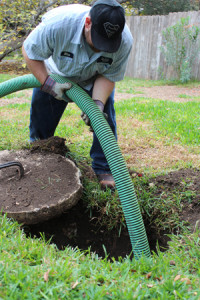For service call (210) 890-2778
or click here to request service
Why You Should Have Your Aerobic System Cleaned

Aerobic septic systems are complicated, with more moving parts and complex electronics than standard systems. For this reason, aerobic systems must be checked more frequently and carefully.
Sludge buildup is a problem
The wastewater first enters the trash tank or compartment. This is where most of the solids are separated from the liquids. The liquids then move into the aerobic unit or compartment, then to the pump tank or compartment.
Over time, the sludge in the trash compartment accumulate and begin to enter the aerobic unit, and then the pump compartment. Activated sludge can build up in the aerobic unit and pass through to the pump tank.
Sludge readings critical
Your maintenance provider should check your aerobic system every four months, and sludge readings should be part of that care. We recommend taking sludge readings in both the aerobic tank and the pump tank. If a high sludge accumulation occurs in either of the tanks, we recommend pumping all the tanks or compartments of the system.
High sludge accumulations in the aerobic tank prevent the bacteria from doing its job and cause insufficient treatment of the wastewater.
High sludge accumulations in the pump tank can cause premature pump failure, it can clog the spray or drip lines, clog the spray heads, or—if it’s bad enough—cause sludge to spray out on the lawn.
How often should my tank be pumped?
All aerobic systems need to be pumped, but the frequency varies greatly from system to system, and depends on the system’s usage. Here are a few factors involved on how often your aerobic system needs to pumped out.
Size of the system
Systems with smaller tanks need more frequent pumpings than systems with larger tanks.
Hydraulic load
More occupants means more wastewater entering the system, so sludge accumulates faster.
Also, surges on the system (using a lot of water within a short time frame) can cause sludge to push through the system faster, causing higher sludge accumulations in the pump tank. This can also occur with drippy faucets and running commodes.
Decreased oxygen
The aerobic bacteria in these systems cannot survive without oxygen. If there is a lack of oxygen, the treatment of the wastewater decreases and sludge can accumulate at a faster rate.
Overfull system
When the compartments are overfull (such as when your submergible pump goes out), it can allow sludge to move more freely between the tanks.
Chemicals, medicines & oils
Cleaning services may use more and stronger chemicals to clean, which can kill the bacteria. Some long-term medication use can have a negative impact on the bacteria in the system, as well as fats, grease, and oils (including tanning oils, bath oils, etc.).
